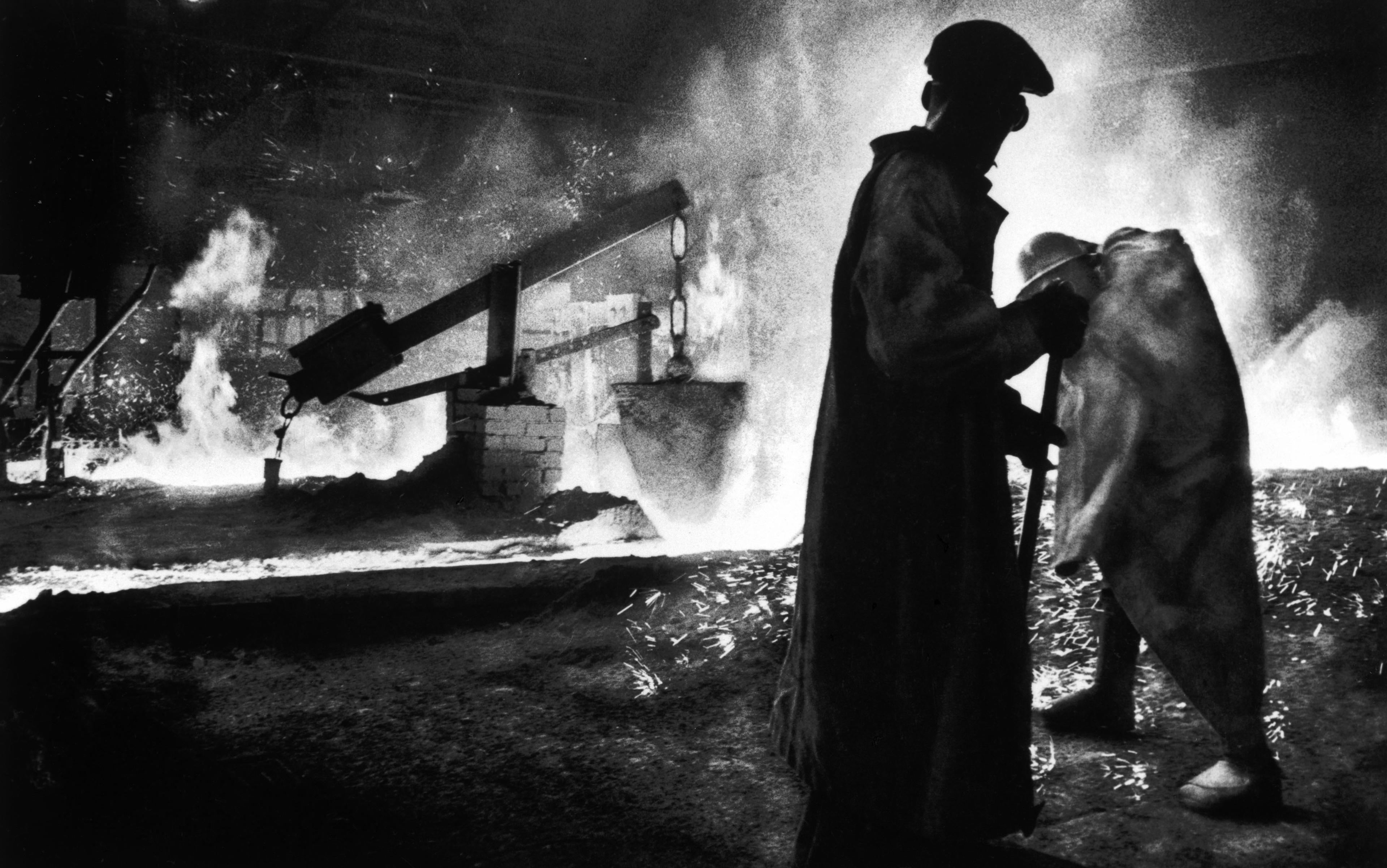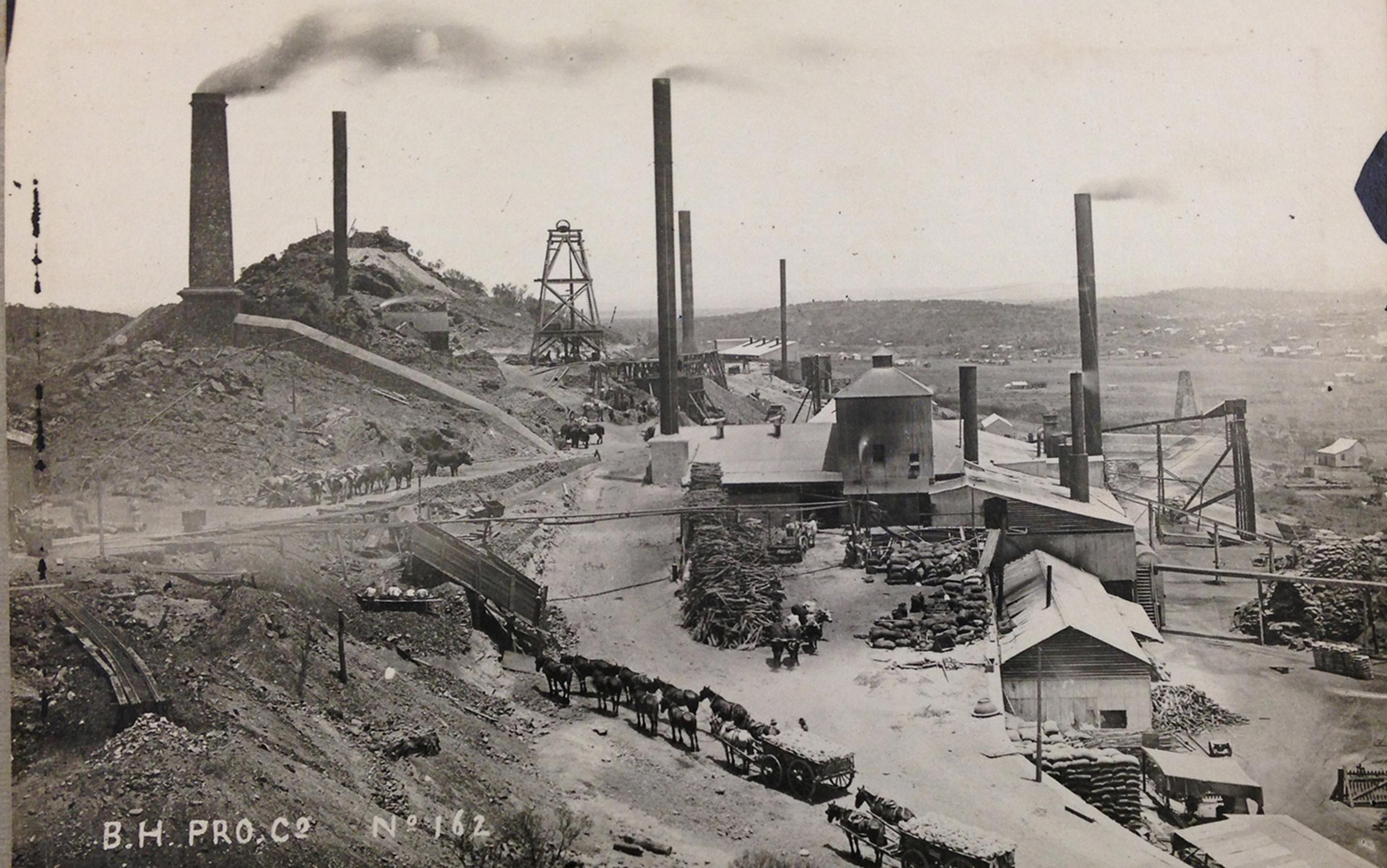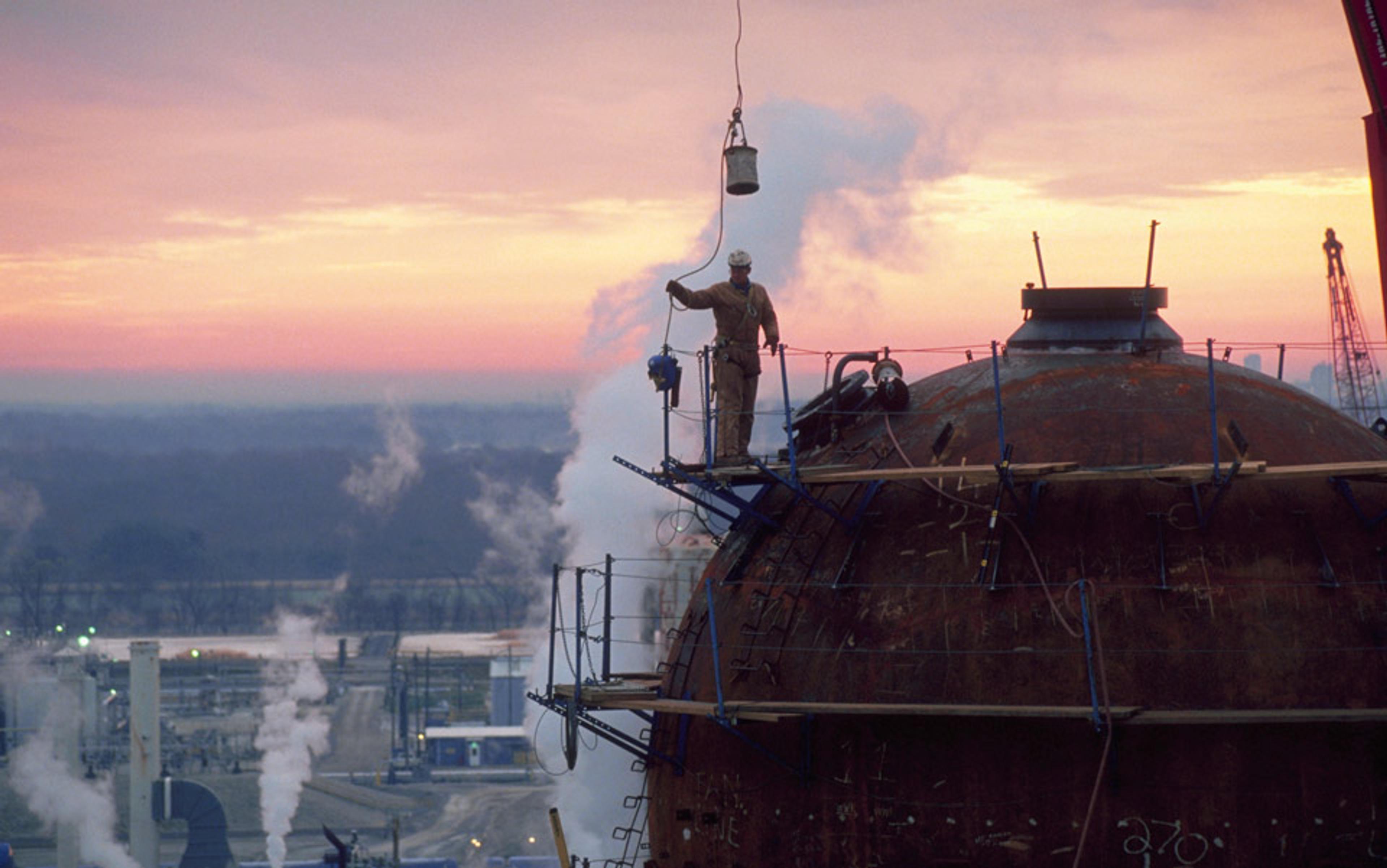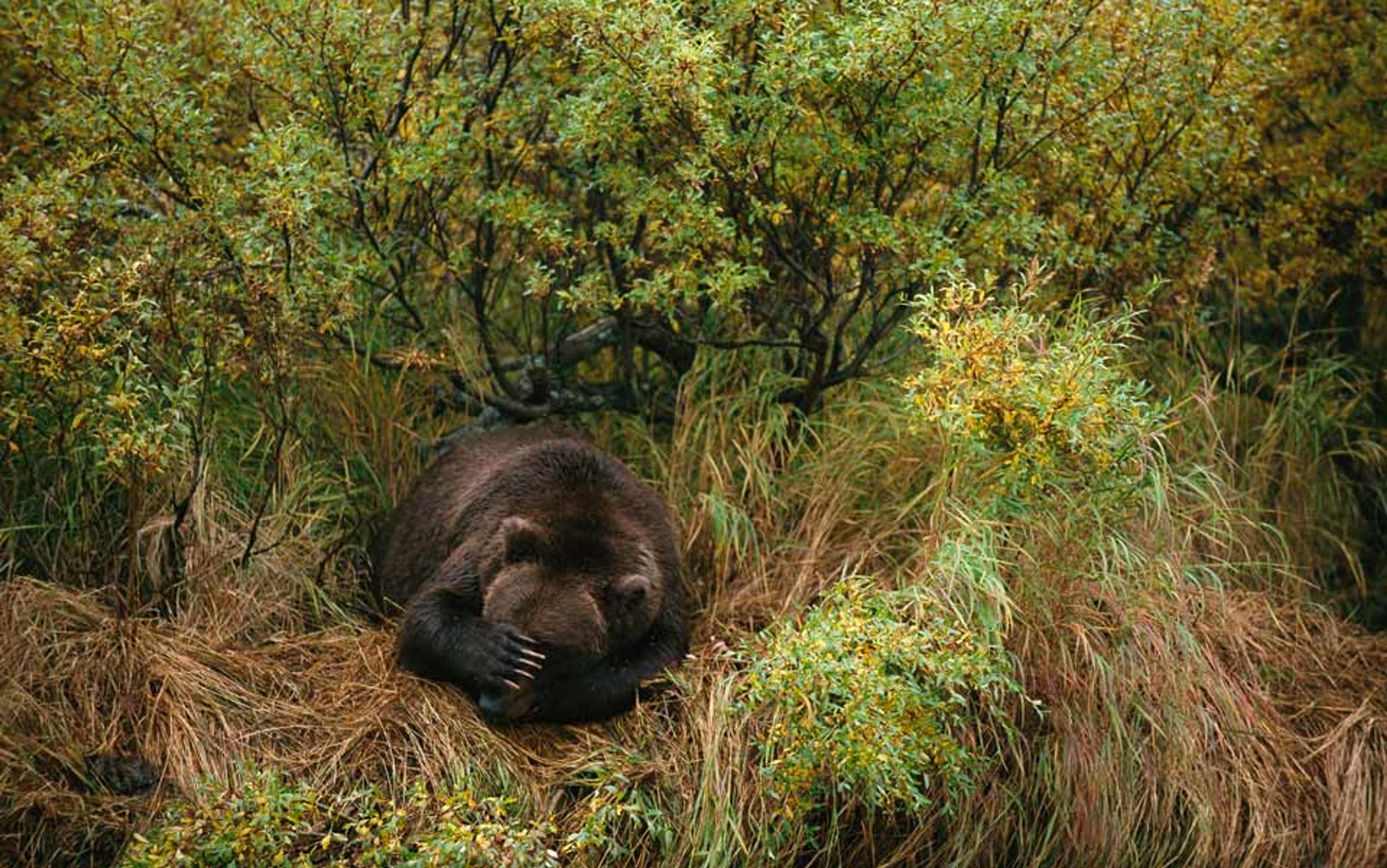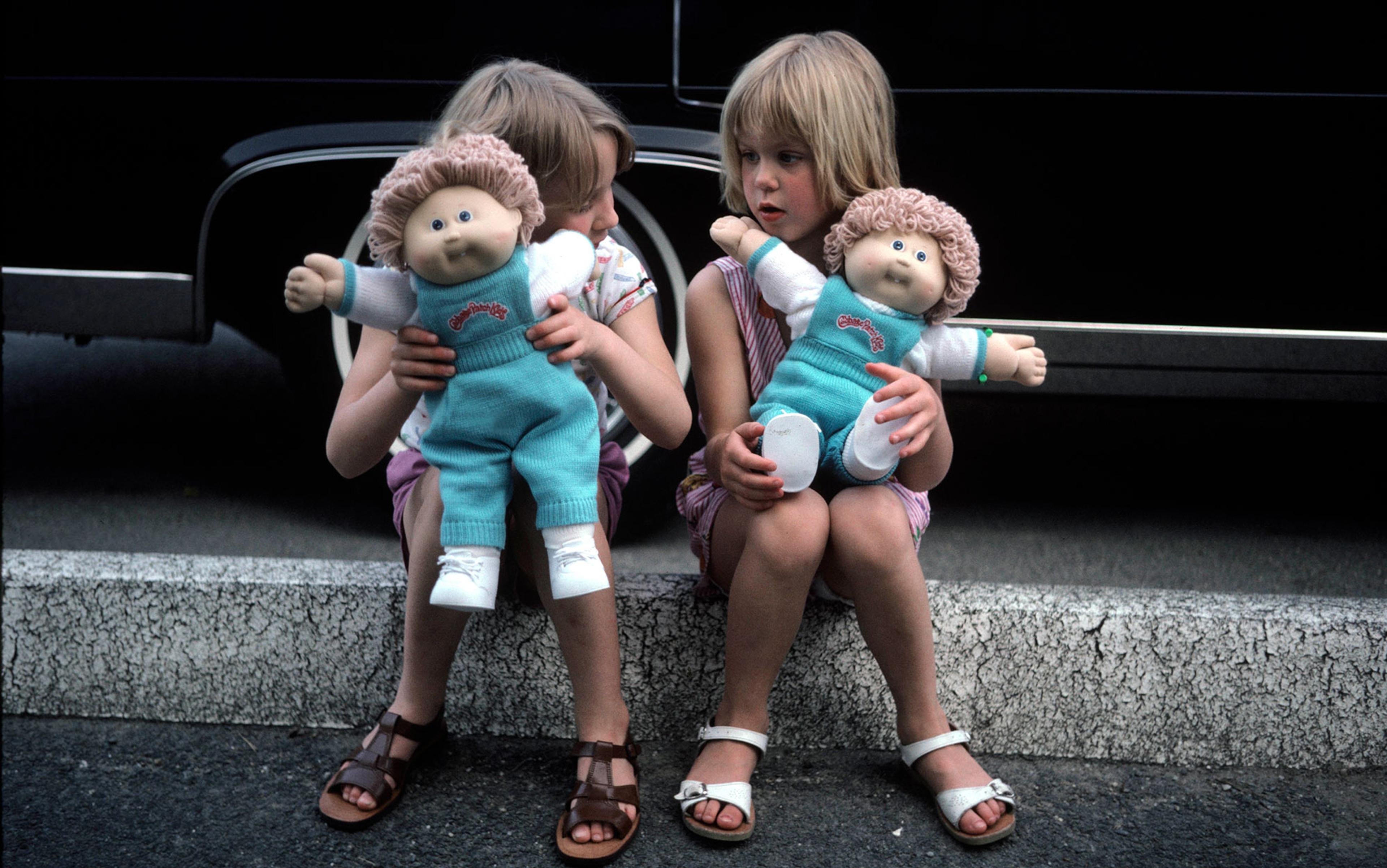Two memorials pay homage to the miners killed in a coal dust explosion on 5 April 2010 at the Upper Big Branch mine in Montcoal, West Virginia. One is a towering black granite monument etched with the silhouettes of the 29 miners, from Cory Davis, who was aged 20, to Benny Willingham, 61. The monument’s inscription reads: ‘Come to Me All You Who Labor and I Will Give You Rest’.
The other memorial, a few miles away at the Brushy Eagle mine, features two rows of small red wooden crosses topped by miniature miner’s hats, each labelled with the name of one of the victims. This homely handmade shrine, hung with bandanas, rosaries and wreaths, has been tagged with graffiti. Scraped into a concrete base at the mine, someone has scrawled a defiant ‘God Bless Coal’.
I paid my respects at these memorials late last summer, after an environmental activist I met on Twitter thought I might see parallels between the steelmaking community where I was raised outside Baltimore and the coal-mining counties of Appalachia. She was right. The green mountain hollows and hamlets of southern West Virginia look nothing like my gritty hometown, but they share a similar history and a similar grief.
The granite marker commemorating the dead of Upper Big Branch reminds me of the monument to workers killed on the job in the Sparrows Point steelworks in my hometown. The 110 names on that monument represent a fraction of the thousands killed or seriously injured at the works throughout its 125 year history, from 1890 to 2012. Members of my own family are among those whose lives were cut short by workplace accidents and occupational diseases. And yet, my community along the Chesapeake Bay in Maryland mourns the demolition of the works that employed more than 30,000 at its mid-century peak.
Thousands of working-class communities around the country lament the shuttering of blast furnaces, coke ovens, mines and factories. This yearning for a vanishing industrial United States, a place in long, slow decline thanks to globalisation and technological change, has a name – smokestack nostalgia. It is a paradoxical phenomenon, considering the environmental damage and devastating health effects of many of the declining industries. Our forebears worked gruelling shifts in dangerous jobs, inhaling toxic fumes and particulates at work and at home. Many lived in neighbourhoods hemmed in by industries that pumped effluent into rivers, streams and creeks.
During the 1960s and ’70s, a fine red dust coated my home town near Sparrows Point. The local rivers and creeks, which fed into the Chesapeake Bay, became so contaminated with run-off that dead fish often littered the beaches. As the Sparrows Point monument testifies, many workers died gruesome deaths: burned, crushed, gassed, dismembered. Others experienced a slower, though no less painful, demise from diseases caused by exposure to asbestos, benzene and other toxins.
Few of the steelworkers I’ve known deny the negative aspects of living and working on the Point, including long-standing racial, class and gender discrimination. Still, they grieve the shuttering of the Sparrows Point works, which provided not just union jobs with generous benefits, but a sense of family and community, identity and self-worth. At a ceremony on 24 November 2014 honouring the legacy and history of Sparrows Point, in advance of the demolition of what was once the largest blast furnace in the western hemisphere, steelworkers described what the Point meant to them. ‘My heart will always be in this place. This is hallowed ground,’ said Michael Lewis, a third-generation steelworker and union officer. Troy Pritt, another steel worker, read a poem calling the steelworks ‘home’.
Industrial workers in the US aren’t alone when it comes to cherishing complicated legacies or yearning for a less than ideal past. Nostalgia was originally defined as a mental disorder by the 17th-century Swiss physician Johannes Hofer, who coined the term to describe ‘the pain a person feels because he is not in his native land, or fears never to see it again’. During the American Civil War, physicians attributed more than 300 deaths to the debilitating effects of nostalgia. Immigrants, too, yearn for the people and places they left behind, even when they are fleeing poverty, pogroms and war.
Today, researchers view nostalgia – ‘a sentimental longing or wistful affection for a period in the past’ – far more positively than their 19th-century forebears. Studies show that nostalgia can serve as a psychological resource that protects and fosters mental health, bolstering a sense of meaning in life and increasing feelings of social connectedness. But there’s a twist – nostalgia appears to be beneficial only when individuals feel a connection between who they are now and who they were in the past, a phenomenon psychologists call ‘identity continuity’.
I could see that nostalgia for a vanishing way of life was tearing communities apart
Absent that sense of connection between past and present, nostalgia becomes a painful reminder of what has been lost and can, according to researchers, lessen people’s willingness to embrace new opportunities and experiences. When people feel the past slipping away, and try desperately to hold onto it, they might sacrifice the long-term benefits of growth and change for the short-term benefits of security and familiarity.
So why do residents of Rust Belt cities and Appalachian hollows cling to memories of mines and factories and fight to hold on to dying, dangerous industries? Perhaps because their sense of who they were ‘then’, when jobs were plentiful and wages were high, doesn’t connect with who they are now, scrambling for minimum wages in big box stores or buying groceries with unemployment and disability checks.
As I drove the winding mountain roads of coal country in West Virginia this summer, I could see that nostalgia for a vanishing way of life was tearing communities apart. ‘Friends of Coal’ placards and banners were common in the front yards of modest homes and posted on the sides of businesses. And anti-coal activists told me they had been attacked and threatened for efforts to ban mountaintop removal mining (MTR), a type of surface mining that recent studies associate with higher rates of birth defects, cancers, and cardiovascular and respiratory disease.
‘There is a genuine human rights crisis in the coal fields,’ said Bob Kincaid, 51, a voluble ninth-generation Appalachian father of four and grandfather of three, the co‑founder of the Appalachian Community Health Emergency Campaign, created in 2012 to educate legislators and the public about the health consequences of mountaintop removal mining and to push for a ban on the practice. I met Kincaid at Pies and Pints, a craft pizza and beer establishment in Fayetteville, West Virginia, a town with a population of 3,000 that was the closest thing to an urban area I saw in days of driving around coal-country USA.
Kincaid’s father and grandfather were coal miners. Like the steelworkers I know, he feels great pride in his family’s history of labour organising and hard, dangerous work. ‘It’s the culture I come from,’ he says. The underground miners that raised him despised surface mining. ‘They understood it was taking away their jobs.’ The underground mining of the past was a labour-intensive process that once provided hundreds of jobs on a single mine. By contrast, MTR and other forms of surface mining rely on explosives and heavy equipment operated by small crews who strip sites of trees and vegetation and then blast through rock using ammonium nitrate and diesel fuel. The explosions spew heavy metals and particulate into the air, creating an ultrafine dust ‘about the size of a virus’ that can travel for miles, said Kinkaid.
In underground coal mining, the risks are borne by individual miners, but in MTR the poisons are visited on the entire community. Rock and soil laced with toxins are dumped in mountain hollows and valleys, burying streams. Some of this overburden is used to create dams that hold back millions of gallons of coal waste produced at processing plants. These ‘slurry’ ponds, known to leach chemicals into aquifers and streams, contaminate groundwater.
Kincaid, who hosts an independent radio show in Fayetteville, has been a vocal opponent of MTR for more than a decade. Yet he doesn’t consider himself an environmentalist. ‘I don’t have time to worry about birds, bugs and beetles when people are dying,’ he said. The fight is personal for him – members of his family have chronic health problems that he attributes to MTR toxins. But his family has also paid a price for his activism. His son was beaten up in school by fellow students chanting ‘tree-hugger’, and his wife was assaulted at a demonstration by a miner’s wife.
Once, the ire of miners and their families was directed at the companies they viewed as exploiting their labour and ignoring their health and safety. Appalachian sites such as Matewan, Blair Mountain, Harlan and Buffalo Creek are hallowed names in US labour history, places where workers and management stood off, natural enemies on the landscape of the fight for human rights. But today, miners are more likely to oppose environmental activists and government regulators they view as enemies bent on destroying not only their livelihoods but also their culture, Kincaid said.
‘My grandfather and others who built the United Mine Workers of America understood that the company was not their friend,’ he says. ‘Today, the UMWA has a bunch of rank-and-file guys who say: “Blow ’em up if it’s gonna give me a job.”’
And even people who oppose mountaintop mining see coal as their legacy – a rich heritage they are sad to let go. Take the now-bedridden Gloria Jean Turner, 70, one of the first female coal miners in the state. She started working in 1975, drilling holes in the roof of the mine and driving in bolts to hold the ceiling in place. ‘I wouldn’t suggest it for everybody, but for me it was the right kind of job,’ she said.
Like so many other folks in this part of West Virginia, mining is in her blood. ‘My daddy was a coal miner born in 1923. Around 1941, he went into the mines. He hand-loaded coal with a shovel. My first husband was a coal miner too.’
Turner worked in the mines for 14 years until black lung disease and back and wrist injuries forced her into retirement. ‘I’ve had three operations on my wrist but it will never be right,’ she said. She also uses oxygen for her lung disease. But she doesn’t regret her history in the mines despite her current troubles. Her wages as a miner allowed her to build the comfortable ranch house where she now lives, and her pension and healthcare keep her going.
Turner told me that when she started in the mines in the 1970s, she made $42 per shift – almost $200 after inflation today. She was making $125 per shift at the time of her retirement, still a comfortable wage. Everything was going well until a non-union mine came in. They paid more than union wages at first but after they ran the union out, pay started going down. It’s $90 per shift now or less, she said. Her youngest son is a non-union miner working on a mountaintop removal site who hasn’t had a raise in a decade.
‘My grandparents come from a radical labour background. It’s the family business’
The villain in Turner’s story is Don Blankenship, the former chief executive officer of Massey Energy, once the largest coal producer in Central Appalachia and operator of the Upper Big Branch mine. Blankenship’s union-busting led to weakened protections for miners. In November 2014 he was indicted in a federal court for conspiring to violate federal mine safety and health standards and impede mine safety officials, leading to the deaths of the 29 miners in Big Branch in 2010.
Shortly after the explosion, Massey Energy was acquired by Alpha Natural Resources, which paid out $209 million in settlements for the Big Branch tragedy. Yet Alpha’s infractions continued apace. In 2014, the company was fined $27.5 million by the US Environmental Protection Agency for toxic discharges into waterways in five Appalachian states. And Alpha is not the only coal company to come under the scrutiny of regulatory officials in recent years. A 2014 investigative series by NPR and Mine Safety and Health News revealed that 2,700 US mining companies owe a combined $70 million in delinquent penalties for safety violations. Most of those penalties are between two and 10 years overdue, though some go back decades. NPR found that injury rates are 50 per cent higher in mines that don’t pay their penalties than in mines that do.
Just before I left West Virginia I met a young activist who helped me understand why so many folks in the state support Big Coal despite such abuses. D. Steele, 23, was born and bred in a hollow (pop 16) near Matewan, site of a 1920 shootout during the bitter struggle to organise the coal fields. Steele was raised by grandfather Terry, a miner, and grandmother Wilma, a teacher. ‘My grandparents come from a radical labour background,’ Steele said. ‘It’s the family business.’
Steele now lives in Whitesville, not far from the Upper Big Branch memorial, in a storefront on the town’s mostly boarded-up main street. The first floor serves as both living quarters and office for Radical Action for Mountains’ and People’s Survival (RAMPS). The organisation, founded in 2011, partners with groups such as Coal River Mountain Watch and Mountain Justice to fight mountaintop removal. In June 2014, eight activists from these organisations, including Steele, were arrested during a protest at the headquarters of Alpha Natural Resources in Bristol, Virginia.
But community support has been weak. Only United Mine Workers of America (UMWA) Local 1440, that of Steele’s grandfather, supported a 2011 March on Blair Mountain for labour rights and against mountaintop removal – following a path trod by 10,000 coal miners for the right to form a union back in 1921. ‘For 120 years, industry has partnered with state to limit options that aren’t related to coal. We want to build an alternative base of power,’ Steele said.
Steele’s dream stands at loggerheads with another enduring belief: that coal remains essential to the region’s economic and psychological health. Shane Simmons, 44, said: ‘People don’t understand that [when a mine closes] it’s not just the mining jobs that go, it’s the other ancillary businesses too. Theatres close, grocery stores lay off. It’s a downward spiral and it’s devastating psychologically; the morale and sense of community suffers.’
Simmons worked in a mine as a young man, following three generations of his family into the coal industry. ‘I didn’t go underground but I got a little taste of that sense of community and fellowship,’ he said. The mining industry has always been boom and bust, he pointed out, and even at its best a miner’s life was a tough one. ‘You’re risking your life and definitely risking your health to take care of your family,’ he said. ‘But there was such a strong sense of community and family there. I think it’s why people cling on so much. You know all your neighbours, you’re related to a lot of people, there is so much attachment.’
‘You get demonised as anti-environment if you speak up for coal’
When he was in high school, there were three options for young people who didn’t attend college, Simmons said: ‘Mining, military or move. Today, there are only two – military and move.’ But as the coal industry continues to contract, providing fewer and fewer jobs, people resist moving away in search of work, even if they suffer financially from the decision to stay put. ‘It’s not that they are lazy or don’t realise there are other things to do,’ he said. ‘But they will sacrifice a lot of other things to be around family.’
Devastated by the effects of job loss in his own hometown, in February last year Simmons began The Appalachian Project, driving around coal country – West Virginia, Kentucky, Tennessee and his home state of Virginia – taking photos and posting them on Instagram and Facebook. In January 2015, he posted a photograph of a lump of black diamond on The Appalachian Project’s Instagram feed, noting in the caption that ‘it has heated many homes and helped to feed many Appalachian families over the years’. The photo got only 78 likes, though The Appalachian Project has more than 1,100 followers on Instagram. ‘You get demonised as anti-environment if you speak up for coal,’ Simmons said. ‘But I’m trying to point out things to be happy and proud about, things we can agree on.’
Psychologists agree that this kind of nostalgia can cushion the blows of change. ‘Nostalgia can be a resource that individuals recruit in times of distress – including stress, loneliness and boredom – to help them cope by fostering feelings of social connectedness, self-esteem and generosity, notes the psychologist Jamie Arndt of the University of Missouri. Nostalgia functions by providing ‘identity continuity’ – the sense of a past, present and future self, united across time. ‘Despite nostalgia’s orientation to the past, it inspires people to engage with the future and to become more generative, more forward-thinking,’ he notes.
But researchers at the University of Queensland in Australia have carried out studies showing that nostalgia’s positive effects evaporate when that sense of continuity is somehow broken and the past is remembered in a bitter or toxic way. In a 2011 paper in the Journal of Personality and Social Psychology, Aarti Iyer and Jolanda Jetten showed that when identity continuity is maintained, high levels of nostalgia improve emotional wellbeing. By contrast, nostalgia has negative consequences when individuals believe that they will not be able to maintain links to a previous identity or familiar surroundings. Then, they become less interested in pursuing new opportunities and less able to cope with challenges and obstacles. ‘It appears that there are circumstances in which nostalgia can stand in the way of individuals moving forward after a life transition,’ they wrote.
What are the implications for workers and their families grappling with the transition to a post-industrial economy in places such as Sparrows Point and the coal-mining counties of Appalachia? Grief for the loss of jobs and a tight-knit work ‘family’ is natural, but two and a half years after the closing of Sparrows Point the folks who are doing best are the ones who have mourned and moved on. Some have taken advantage of federal programs providing funds for education and training in new professions. Others have transferred the skills they acquired in their former jobs to different industries.
‘I was able to turn my grief into determination. I was not going to let the closing of the steel mill define me,’ said Troy Pritt, who will graduate with a bachelor’s degree in business administration this May. ‘Strength of character, being a hard worker, and the drive to succeed were skills that I learned in the mill and those skills were transferable to the classroom.’
A kind of scrappy resilience characterises those successfully navigating the transition; they accept that the old way of life is gone and have taken concrete steps to create a new future. ‘I came to the realization pretty quickly that I needed to start something new,’ said Lisa Zulauf, 26, a former Sparrows Point crane operator who began training as a medical assistant two months after the plant shutdown. Zulauf will graduate this spring and has already been offered a job at the surgical centre where she did her internship. ‘I’m going to nursing school next.’
Policy-makers need to recognise that the losses are real – not just the economic losses but also the loss of personal and community identity that ensues when a longtime employer shuts down or an industry withers away. The liberal media tends to focus on issues of income inequality and the gutting of the US middle class. Conservative media stresses cultural displacement. Both express nostalgia for a lost golden age but neither pays much attention to the victims of smokestack America: retirees disabled by occupational diseases, the widows and orphans of men killed on the job, late-middle-age workers too young to retire but too old to start over. The last name on the Sparrows Point memorial is Robert Jennings, aged 59, who shot himself months after the works shut down, despairing that he would lose his home and all that he had worked for in a 30-year career on the Point.
Nostalgia as a springboard to growth was evident at the Sparrows Point tribute last year. Former employees of Bethlehem Steel spoke both of their pride in working at ‘the mill that made America’ and their hope for new family-supporting jobs at a site where coke ovens and furnaces once belched fire and smoke. A partnership between local investors and the government will include a costly clean-up to purge a witches’ brew of toxic chemicals – arsenic, cyanide, lead – and the creation of a 21st-century manufacturing and distribution hub.
‘There’s a bit of sadness in saying goodbye to a legacy, but we’re working hard to bring hope to the future,’ said Michael Pedone, chief operating officer of the new Sparrows Point Terminal. One way to honour such legacies is to ensure that the descendants of miners and millworkers no longer have to build memorials for the dead paid for by the companies that killed them. If nostalgia’s function is to knit together the past, present and future, perhaps we ought to ensure that the ties that bind are those of pride and respect, not exploitation and grief.
